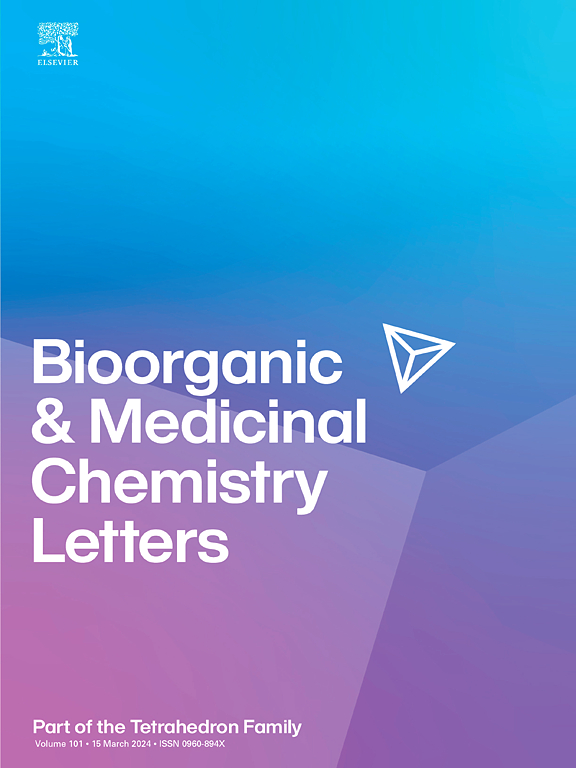In-vitro evaluation of cationic Lipopeptides as adjuvant candidate for DNA plasmid vaccine
IF 2.5
4区 医学
Q3 CHEMISTRY, MEDICINAL
引用次数: 0
Abstract
Lipopeptides with different fatty acids (palmitic, palmitoleic, stearic, oleic, and linoleic acids) conjugated to CHSPKKKRKV were synthesised by a solid-phase peptide method using the Fmoc strategy (Fmoc-SPPS) on 2-CTC (2-chlorotritylchloride) resin. The lipopeptides were purified by RP-HPLC and characterised by ToF-ESI-MS and 1D-NMR. The capability of the lipopeptide to interact with the plasmid was evaluated by DNA agarose gel electrophoresis. The particle size of the lipopeptide/DNA complexes was determined by dynamic light scattering assay and TEM analysis. The biological activities including cytotoxicity, nitrite oxide (NO) release, and IL-6 and TNF-α production were evaluated in RAW 264.7 cells. ToF-ESI-MS revealed [M + 2H]2+ and [M + 3H]3+ ion peaks which were validated by 1H NMR and 13C NMR, confirming the lipopeptide molecular structure. All lipopeptides condensed and protected the DNA plasmid from enzymatic degradation at the lipopeptide/DNA mass ratio of 2:1. In addition, the size of the cationic lipopeptide/DNA complexes ranged from ∼250 to 700 nm. The lipopeptides showed moderate cytotoxicity with IC50 values ranging from 120 to 190 ppm, induced NO release (275–1060 ppm) and IL-6 (40–497 pg) and TNF-α (150–270 pg) production with the highest level achieved by C(18,0)-CHSPKKKRKV. In conclusion, CHSPKKKRKV-based lipopeptides with different fatty acids are potential adjuvant candidates but further evaluation in animal models is required.

阳离子脂肽作为DNA质粒疫苗佐剂的体外评价
采用固相多肽法,在2-CTC(2-氯三烷基氯)树脂上采用Fmoc策略合成了不同脂肪酸(棕榈酸、棕榈油酸、硬脂酸、油酸和亚油酸)与CHSPKKKRKV偶联的脂肽(Fmoc- spps)。采用反相高效液相色谱法纯化脂肽,并用ToF-ESI-MS和1D-NMR进行表征。用DNA琼脂糖凝胶电泳评价脂肽与质粒的相互作用能力。采用动态光散射法和透射电镜分析测定脂肽/DNA复合物的粒径。在RAW 264.7细胞中评估生物活性,包括细胞毒性、亚硝酸盐氧化物(NO)释放、IL-6和TNF-α的产生。ToF-ESI-MS显示[M + 2H]2+和[M + 3H]3+离子峰,经1H NMR和13C NMR验证,证实了脂肽的分子结构。所有的脂肽在脂肽/DNA质量比为2:1时浓缩并保护DNA质粒免受酶降解。此外,阳离子脂肽/DNA复合物的大小范围为~ 250 ~ 700 nm。脂肽表现出中等的细胞毒性,IC50值在120 ~ 190 ppm之间,诱导NO释放(275 ~ 1060 ppm)和IL-6 (40 ~ 497 pg)和TNF-α (150 ~ 270 pg)的产生,其中C(18,0)-CHSPKKKRKV达到最高水平。综上所述,基于chspkkkrkv的脂肽具有不同的脂肪酸,是潜在的佐剂候选物,但需要在动物模型中进一步评估。
本文章由计算机程序翻译,如有差异,请以英文原文为准。
求助全文
约1分钟内获得全文
求助全文
来源期刊
CiteScore
5.70
自引率
3.70%
发文量
463
审稿时长
27 days
期刊介绍:
Bioorganic & Medicinal Chemistry Letters presents preliminary experimental or theoretical research results of outstanding significance and timeliness on all aspects of science at the interface of chemistry and biology and on major advances in drug design and development. The journal publishes articles in the form of communications reporting experimental or theoretical results of special interest, and strives to provide maximum dissemination to a large, international audience.

 求助内容:
求助内容: 应助结果提醒方式:
应助结果提醒方式:


